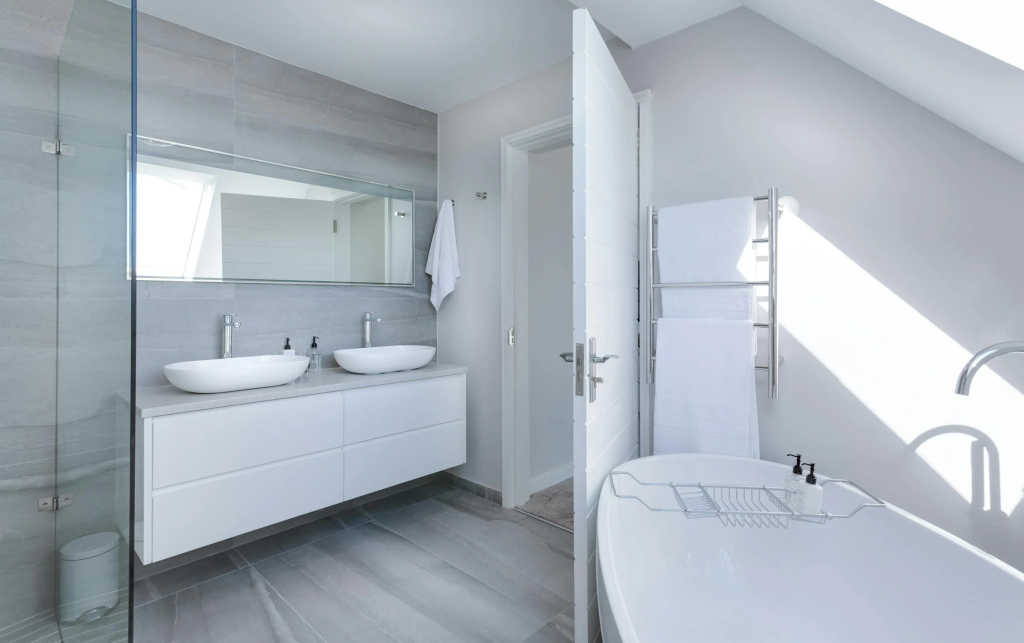A well-planned restroom is more than simply a place to wash one’s hands; it’s an oasis where practicality, aesthetics, and comfort come together. It takes time and effort to design a bathroom layout that is practical and useful while also meeting your demands.

Every detail, from making the most efficient use of space and directing traffic to choosing the appropriate fixtures and materials, contributes significantly to the overall goal of achieving a pleasant and functional atmosphere.
To help you create a bathroom that is both aesthetically pleasing and functionally sound, we’ll go over some of the most important rules of thumb for bathroom design.
What Makes A Good Bathroom Layout?
A good bathroom layout balances functionality, comfort, and aesthetics. Here are key elements to consider:
- Space Efficiency: Make the most of available space by choosing compact fixtures and organizing storage efficiently.
- Functional Zones: Separate areas for bathing, showering, and using the toilet ensure smooth flow. Consider a clear division between the shower and toilet areas.
- Clear Pathways: Ensure there’s ample space to move around comfortably. Avoid overcrowding the layout with too many fixtures.
- Lighting: Incorporate a mix of ambient, task, and accent lighting. Good lighting around mirrors is essential for tasks like shaving or applying makeup.
- Ventilation: Proper ventilation prevents mould and mildew. An exhaust fan or a window is crucial for maintaining air quality.
- Storage Solutions: Built-in shelves, cabinets, or floating vanities keep the space organized and clutter-free.
- Accessibility: Ensure that fixtures are easily accessible and consider the needs of all users, including those with mobility issues.
- Aesthetics: Choose materials, colours, and fixtures that reflect your style while maintaining harmony with the rest of the home.
- Water Efficiency: Opt for water-saving fixtures to reduce utility bills and environmental impact.
- Safety: Non-slip flooring, rounded edges on counters, and grab bars in the shower can enhance safety.
Considering these factors can help you create a bathroom that’s both practical and enjoyable.
What Is A Bathroom Renovation?
A bathroom renovation is a process of updating, remodelling, or completely overhauling an existing bathroom to improve its functionality, aesthetics, or both. This can range from simple updates to extensive changes, and it typically involves several key aspects:
- Design and Planning: This involves deciding on the new layout, style, and features of the bathroom. It includes selecting fixtures, materials, colours, and any additional features such as new lighting or storage solutions.
- Demolition: If the renovation involves significant changes, the existing fixtures, tiles, and other elements may need to be removed. This step prepares the space for new installations.
- Structural Changes: This might include altering the layout, moving walls, or reconfiguring plumbing and electrical systems to accommodate new fixtures or to create a more functional layout.
- Plumbing and Electrical Work: Upgrading or repositioning plumbing and electrical systems to support new fixtures or to enhance functionality. This could involve installing new pipes, updating wiring, or adding outlets and lighting.
- Installation of Fixtures and Fittings: This includes installing new items such as a toilet, sink, shower, bathtub, cabinets, and countertops. It may also involve installing new flooring and wall coverings.
- Finishing Touches: Adding final details such as paint, grout, hardware, and accessories to complete the look of the bathroom. This step enhances both the functionality and aesthetic appeal of the space.
- Inspection and Cleanup: Ensuring that all work meets safety codes and standards. This step also includes cleaning up any debris from the renovation process and preparing the bathroom for use.
A bathroom renovation can range from minor updates like replacing fixtures or painting to major remodels that involve changing the layout or upgrading all elements of the space. The goal is to create a bathroom that better suits your needs, improves its overall appearance, and increases comfort and functionality.
How Do I Choose The Right Bathroom Design?
Choosing the right bathroom design involves balancing your style with practical needs. Here’s a step-by-step approach to help you select the perfect design:
- Assess Your Needs: Consider who will use the bathroom and how. Think about whether it will be a family bathroom, a guest bathroom, or an ensuite. Identify any special requirements, such as accessibility features or additional storage.
- Set a Budget: Determine how much you’re willing to spend. Your budget will influence the choice of materials, fixtures, and the scale of the renovation.
- Choose a Style: Decide on a design style that suits your taste and complements the rest of your home. Popular styles include modern, traditional, rustic, and minimalist. Consider elements like colour schemes, finishes, and fixtures that align with your chosen style.
- Prioritize Functionality: Ensure the design enhances the bathroom’s functionality. Think about the placement of fixtures, storage solutions, and traffic flow. Incorporate features that make daily routines easier, such as a double vanity for shared spaces or a built-in shower bench for comfort.
- Maximize Space: Optimize the layout to make the most of the available space. In smaller bathrooms, consider space-saving fixtures like a corner sink or wall-mounted toilet. For larger bathrooms, think about creating distinct zones for different activities.
- Select Materials and Finishes: Choose durable, easy-to-maintain materials that suit your style and budget. Consider factors like water resistance, ease of cleaning, and longevity. Popular options include ceramic tiles, glass, and natural stone.
- Lighting and Ventilation: Ensure the bathroom has adequate lighting for both general illumination and task lighting. Proper ventilation is also crucial to prevent mould and mildew.
- Incorporate Storage: Plan for ample storage to keep the bathroom organized and clutter-free. Options include built-in cabinets, floating shelves, or vanity storage.
- Personal Touches: Add personal touches to make the space feel uniquely yours. This could include decorative elements like artwork, plants, or stylish accessories.
- Consult a Professional: If you’re unsure about the design or layout, consider consulting a bathroom designer or architect. They can provide expert advice and help bring your vision to life while ensuring that all practical aspects are covered.
By following these steps, you’ll be able to create a bathroom design that is both functional and reflective of your style.
What Makes A Successful Bathroom?
A successful bathroom seamlessly blends functionality, comfort, and style. Here are key elements that contribute to a successful bathroom:
- Functional Layout: The design should optimize space and create a logical flow. Essential fixtures (toilet, sink, shower, or bath) should be arranged to maximize ease of use and accessibility.
- Adequate Storage: Well-planned storage solutions help keep the space organized and clutter-free. This can include built-in cabinets, shelves, and drawers to accommodate toiletries, towels, and cleaning supplies.
- Quality Materials: Choose durable, water-resistant materials that can withstand the bathroom’s humid environment. High-quality tiles, countertops, and fixtures ensure longevity and easy maintenance.
- Effective Lighting: A mix of ambient, task, and accent lighting creates a well-lit environment. Bright, focused lighting around mirrors is essential for tasks like shaving or applying makeup, while softer lighting can create a relaxing atmosphere.
- Good Ventilation: Proper ventilation prevents mould and mildew growth. An efficient exhaust fan or a window can help maintain air quality and manage moisture levels.
- Comfort and Accessibility: Consider the comfort of all users by incorporating features like a comfortable shower or bath, adjustable showerheads, and non-slip flooring. Accessibility features like grab bars or a walk-in shower can also enhance usability.
- Aesthetic Appeal: The design should reflect your style and complement the rest of your home. A cohesive colour scheme, matching fixtures, and tasteful decor contribute to the bathroom’s overall look and feel.
- Water Efficiency: Opt for water-saving fixtures to reduce water consumption and lower utility bills. Modern toilets, faucets, and showerheads often offer efficient performance without sacrificing comfort.
- Safety Features: Include safety elements such as non-slip flooring, rounded edges on counters, and well-placed grab bars. These features are especially important in preventing accidents and ensuring a safe environment.
- Maintenance and Cleanliness: Design with ease of maintenance in mind. Choose materials and finishes that are easy to clean and resist stains and grime.
When these elements are thoughtfully combined, the result is a bathroom that is not only functional and comfortable but also aesthetically pleasing and enjoyable to use.
Conclusion
Renovating your bathroom is a great way to update one of the most used rooms in your house while also making it more beautiful, functional, and comfortable. Planning and thinking about the design, layout, and materials is essential to getting a good outcome whether you’re doing a small update or a major overhaul.
Making thoughtful use of space, selecting high-quality fixtures, and paying close attention to features like lighting and storage may help you design a bathroom that is both functional and aesthetically pleasing. In the long run, a well-executed remodel will do wonders for your home’s value and comfort, as well as your everyday life.
Click this website for more information.
